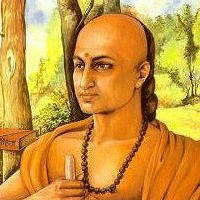Charaka
Charaka (sometimes spelled Caraka) (c 400-200 BC) is believed to be one of the principal contributors to the ancient art and science of Ayurveda, a system of medicine and lifestyle developed in ancient India. He is referred to as the Father of Medicine and the ayurvedic counterpart to Hippocrates. It is believed that Charaka was a resident of Kapisthala village in the Punjab, situated between the Rivers Iravati and Chandrabhaga. Some even believe that his actual name was Kapishthala. Charaka also means “wandering scholars” or “wandering physicians”.
Although Charaka is believed to have contributed significantly to Ayurveda, there is no specific reference to such input. Despite much research, it is still doubtful whether Charaka was a person or a community. According to the Charaka tradition, there existed six schools of medicine, founded by the disciples of the Hindu sage, Punarvasu Ä€treya. Each of his disciples – Agnivesha, Bhela, JatÅ«karna, ParÄshara, HÄrÄ«ta, and KshÄrapÄni – composed a ‘SamhitÄ’. Of these, the one composed by Agnivesha was considered the best.
Charaka is believed to be the first ‘doctor’ to study the human’s digestive function, metabolic rate and resistance. According to Charaka, health and disease are not predetermined and life may be prolonged by human effort and attention to lifestyle. He seems to have been an early proponent of the prevention is better than the cure doctrine.
According to his translations of the Vedas, an individual body contains three ‘doshas’ (humours) – activity (vata), modification (pitta) and oiling and balance (kapha). The ‘doshas’ are created when ‘dhatus’ (blood, skin and marrow) act upon the diet of the individual. Although most people eat a similar diet, each individual generates different quantities of ‘dosha’. This explains why different people have different traits, e.g. weight, stamina, etc. Charaka also believed that illness is triggered when the balance between the three ‘doshas’ is disrupted. To recover the balance he recommended therapeutic medication.
Charaka is believed to have known the fundamentals of genetics. For example, he knew the factors determining the sex of a child and a genetic defect in a child, e.g. blindness was because of defective ovum or sperm.
Charaka must have studied the anatomy of the human body and various organs. He gave 360 as the total number of bones, including teeth, present in the human body. He wrongly believed that the heart had one cavity, but he was right when he considered it to be a controlling centre. He claimed that the heart was connected to the entire body through 13 main channels. Apart from these channels, there were countless other ones of varying sizes that supplied nutrients to various tissues and also provided passage for waste products. He also claimed that any obstruction in the main channels led to a disease or deformity in the body.
The key contributions of Charaka are:-
Ø a rational approach to the causation and cure of disease
Ø introduction of objective methods of clinical examination.
Ayurveda
Ayurveda means ‘the science of living (longevity)’ and is believed to be about 5000 years old, predating all other medical systems. ‘Ayu’ means life and ‘Veda’ means knowledge. The origins of this system of medicine are lost in the very distant past. The body of knowledge that comprises ayurveda includes ideas about diseases, diagnosis and cure that have been accumulated over the ages. It is the indigenous form of Indian medicine. There are two ancient text books of ayurveda.
‘Charaka Samhita’
Agnivesha, under the guidance of the ancient physician Atreya, had written an encyclopaedic treatise in the 8th century B.C. called the ‘Agnivesha-Tantra’. However, it was only when Charaka revised this treatise that it gained popularity as the ‘Charaka Samhita’. The two versions, the original and the later modification, set out the principles of health maintenance and treatment of diseases.
The ‘Charaka Samhita’ survives in the form of the Bower Manuscript (4th Century AD). It contains 120 chapters – ‘adhyayas’ – each divided into 8 sections – ‘aá¹£á¹Äá¹…ga sthÄna’. The 8 sections are as follows:-
1. ‘SÅ«tra sthÄna’ – fundamentals and basic principles of ayurvedic practice, e.g. healthy living, collection of drugs and their uses, remedies, diet and duties of a physician.
2. ‘NidÄna sthÄna’ – the pathology of eight chief diseases.
3. ‘VimÄna sthÄna’ – pathology, various tools of diagnostics & medical studies and conduct.
4. ‘ŚÄrÄ«ra sthÄna’ – the embryology and anatomy of a human body.
5. ‘Indriya sthÄna’ – diagnosis and prognosis of disease on the basis of senses.
6. ‘CikitsÄ sthÄna’ – special therapy.
7. ‘Kalpa sthÄna’ – usage and preparation of medicine.
8. ‘Siddhi sthÄna’ – general principles of ‘Panchkarma’.
The ‘Charaka Samhita’ describes the medicinal qualities and functions of 100,000 herbal plants. It emphasises the influence of diet and activity on the mind and the body and the correlation between spirituality and physical health. The work contributed greatly to diagnostic and curative sciences. It also prescribed an ethical charter for medical practitioners two centuries prior to the Hippocratic Oath. For two millennia it remained a standard work on ayurveda and was translated into many foreign languages, including Arabic and Latin.
‘Sushruta-Samhita’
The ‘Sushruta-Samhita’ is a compilation of oral material passed down verbally from generation to generation and describes elaborate surgical procedures, including reconstructive plastic surgery, gallbladder removal and other operations that most people consider modern.

Charaka
Date of Birth: 18 Oct 2025
Birth Place:
Proffession: ancient art and science of Ayurveda
Nationality: India


